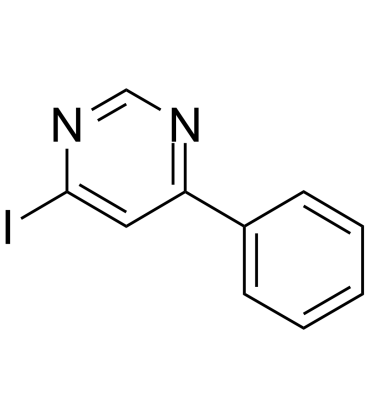| Cas No.: | 41270-96-6 |
| SMILES: | IC1N=CN=C(C2C=CC=CC=2)C=1 |
| Formula: | C10H7In2 |
| M.Wt: | 282.08 |
| Purity: | >98% |
| Sotrage: | 2 years -20°C Powder, 2 weeks 4°C in DMSO, 6 months -80°C in DMSO |
| Publication: | [1]. Zheng L, et al. Macrophage migration inhibitory factor (MIF) inhibitor 4-IPP suppresses osteoclast formation and promotes osteoblast differentiation through the inhibition of the NF-κB signaling pathway. FASEB J. 2019 Jun;33(6):7667-7683. |
| Description: | 4-IPP (4-Iodo-6-phenylpyrimidine) is a specific suicide substrate and irreversible inhibitor of macrophage migration inhibitory factor (MIF)[1]. |
| Target: | MIF[1] |
| In Vivo: | 4-IPP (1 mg/kg, 5 mg/kg; every 2 days; for 8 weeks) ameliorates the bone loss associated with estrogen deficiency by reducing osteoclastic activities and enhancing osteoblastic bone formation[1]. Animal Model: 8-weeks-old C57BL/6J male mice[1] Dosage: 1 mg/kg, 5 mg/kg Administration: Intraperitoneal injection; every 2 days; for 8 weeks Result: Alleviated OVX-induced osteoporosis. |
| In Vitro: | 4-IPP is a specific suicide substrate for MIF that binds covalently and irreversibly to MIF to inhibit its biologic activity[1]. 4-IPP inhibits RANKL-induced p65 phosphorylation and nuclear translocation by preventing the interaction of MIF with thioredoxin-interacting protein-p65 complexes[1]. 4-IPP can inhibit receptor activator of NF-κB ligand (RANKL)-induced osteoclastogenesis and potentiate osteoblast-mediated mineralization and bone nodule formation[1]. 4-IPP (0.5-200μM;24-72 hours) inhibits osteoclastogenesis in a dose-dependent manner[1]. 4-IPP(5-20μM; 5 days) inhibits RANKL-induced osteoclast differentiation and bone resorption [1]. Cell Cytotoxicity Assay[1] Cell Line: BMMs Concentration: 0.5 μM, 1 μM, 2.5 μM, 5 μM, 10 μM, 25 μM, 50 μM, 100 μM, 200 μM Incubation Time: 24 hours, 72 hours Result: Inhibited osteoclastogenesis in a dose-dependent manner. Western Blot Analysis[1] Cell Line: BMMs Concentration: 5 μM,10 μM, 20 μM Incubation Time: 1 day, 3 days, 5 days Result: Inhibited RANKL-induced osteoclast differentiation and bone resorption. |
| References: | [1]. Zheng L, et al. Macrophage migration inhibitory factor (MIF) inhibitor 4-IPP suppresses osteoclast formation and promotes osteoblast differentiation through the inhibition of the NF-κB signaling pathway. FASEB J. 2019 Jun;33(6):7667-7683. |

 To enhance service speed and avoid tariff delays, we've opened a US warehouse. All US orders ship directly from our US facility.
To enhance service speed and avoid tariff delays, we've opened a US warehouse. All US orders ship directly from our US facility.




















